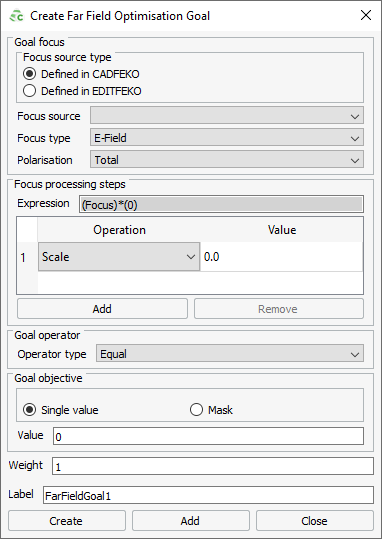Far Field Goal
Optimise the far fields that are solved as part of the Feko model.
 Figure 1. The Create Far Field Optimisation Goal dialog.
Figure 1. The Create Far Field Optimisation Goal dialog.The Focus source is identified based on the label of a Far fields request in CADFEKO or the Focus source label of an FF card in EDITFEKO.
The following focus types can be optimised:
- E-field
- The E-field focus type considers the radiated fields associated with a specific far field solution request directly. The fields are considered according to the settings of the far field request. For example if only the scattered fields from a single object are requested, then only these will be taken into account in the goal evaluation.
- Directivity, Gain and Realised gain
- With this focus type, only the directivity, gain or realised gain of the model is considered. This option can only be based on a far field request where the Calculate fields as specified option is chosen and is independent of whether Directivity or Gain is selected in the far field request.
- Radar cross section (RCS):
- This focus type is only valid for far field solutions that have been computed with a plane wave source. The RCS focus type delivers non-complex values (or an array of non-complex values) representing the derived RCS (see section) according to the options set in the far field calculation request. If no valid RCS information is found in the computation output, an error will be generated during the goal evaluation.
Polarisation
- Total
- For the E-field focus type, the
Total option provides a magnitude combination
of the
- and
-components of the far field. The total
field is calculated as:This value is representative of the power in the far field.
(1) - Horizontal (Phi)/Vertical (Theta)
- These options allow specific selection of the - and -directed components of the far field. For the Directivity, Gain and Realised gain focus types, only the component of the field with the selected polarisation is used in the calculation of the required quantity, delivering a non-complex value (or array of non-complex values).
- LHC/RHC
- These options allow specific selection of the left-hand-circular and right-hand-circular components of the far field (see section). For the Directivity, Gain and Realised gain focus types, only the component of the field with the selected polarisation is used in the calculation of the required quantity, delivering a non-complex value (or array of non-complex values).
- S/Z
- These options allow specific selection of the S- or Z-polarised components of the far field (see section ). For the Directivity, Gain and Realised gain focus types, only the component of the field with the selected polarisation is used in the calculation of the required quantity, delivering a non-complex value (or array of non-complex values).
- Axial ratio
- This option is only available for the E-field focus type. This provides the ratio between the magnitudes of the - and -directed field components (see section).
- Ludwig III (Co and Cross)
- These options allow specific selection of the Ludwig III (Co) and Ludwig III (Cross) polarised components of the far field (see section).